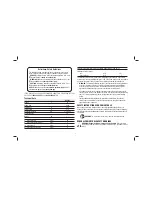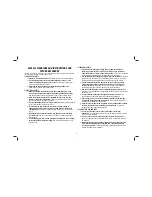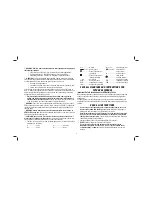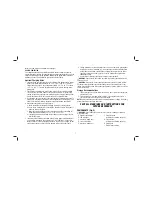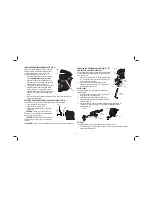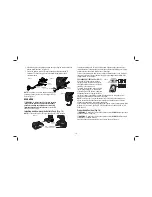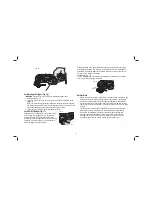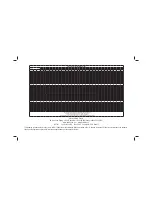
7
NOTE:
This could also mean a problem with a charger.
PROBLEM POWERLINE
Some chargers have a problem powerline indicator. When the charger is used with
some portable power sources such as generators or sources that convert DC to AC, the
charger may temporarily suspend operation, flashing the red light with two fast blinks
followed by a pause. This indicates the power source is out of limits.
Important Charging Notes
1. Longest life and best performance can be obtained if the battery pack is charged
when the air temperature is between 18 ° – 24 °C (65 °F and 75 °F). DO NOT
charge the battery pack in an air temperature below +4 °C (+40 °F), or above
+40 °C (+105 °F). This is important and will prevent serious damage to the
battery pack.
2. The charger and battery pack may become warm to the touch while charging.
This is a normal condition, and does not indicate a problem. To facilitate the
cooling of the battery pack after use, avoid placing the charger or battery pack in
a warm environment such as in a metal shed or an uninsulated trailer.
3. A cold battery pack will charge at about half the rate of a warm battery pack. The
battery pack will charge at that slower rate throughout the entire charging cycle
and will not return to maximum charge rate even if the battery pack warms.
4. If the battery pack does not charge properly:
a. Check operation of receptacle by plugging in a lamp or other appliance;
b. Check to see if receptacle is connected to a light switch which turns power off
when you turn out the lights;
c. Move the charger and battery pack to a location where the surrounding air
temperature is approximately 18 ° – 24 °C (65 °F and 75 °F);
d. If charging problems persist, take the tool, battery pack and charger to your
local service center.
5. The battery pack should be recharged when it fails to produce sufficient power
on jobs which were easily done previously. DO NOT CONTINUE to use under
these conditions. Follow the charging procedure. You may also charge a partially
used pack whenever you desire with no adverse effect on the battery pack.
6. Foreign materials of a conductive nature such as, but not limited to, grinding dust,
metal chips, steel wool, aluminum foil, or any buildup of metallic particles should
be kept away from charger cavities. Always unplug the charger from the power
supply when there is no battery pack in the cavity. Unplug the charger before
attempting to clean.
7. Do not freeze or immerse the charger in water or any other liquid.
WARNING:
Shock hazard. Don’t allow any liquid to get inside the charger. Electric
shock may result.
WARNING:
Burn hazard. Do not submerge the battery pack in any liquid or allow
any liquid to enter the battery pack. Never attempt to open the battery pack for any
reason. If the plastic housing of the battery pack breaks or cracks, return to a service
center for recycling.
Storage Recommendations
1. The best storage place is one that is cool and dry, away from direct sunlight and
excess heat or cold.
2. For long storage, it is recommended to store a fully charged battery pack in a
cool dry place out of the charger for optimal results.
NOTE:
Battery packs should not be stored completely depleted of charge. The battery
pack will need to be recharged before use.
SAVE ALL WARNINGS AND INSTRUCTIONS FOR
FUTURE REFERENCE
COMPONENTS (Fig. 2)
WARNING:
Never modify the power tool or any part of it. Damage or personal
injury could result.
A. Variable speed trigger
B. LED worklight
C. Accessory clamp lever
D. Lock on/off button
E. Accessory side mount
F. Cut guide block
(available in selected model only)
G. Cut guide arm
(available in selected model only)
H. Battery pack
I. Battery release button
Summary of Contents for XR Li-Ion DCS355-XE
Page 1: ...DCS355 XE 18V BRUSHLESS CORDLESS MULTI TOOL INSTRUCTION MANUAL ...
Page 2: ......
Page 15: ......



